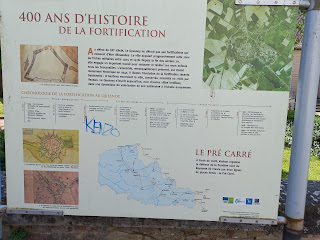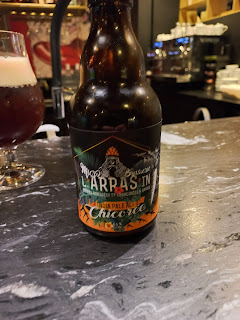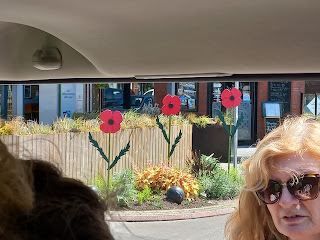Unfortunately for Dave, after coming all this way and battling getting on and off numerous trains, today was a national holiday so nothing was open. We got here about 9am and were looking at a deserted ghost town, no cars, no people, no shops or cafes open, and most importantly the isite was closed which offered a self-guided map of the historic fortresses and NZ street names etc. So luckily the place is not very big (8500 people - where are they all?) and cobble stoned so walking around it with the use of google was easy. And yes there were lots of oak trees.
There was a moat of water inbetween two high walls to prevent invaders.
The origional gated entrance to the village.
As we got closer to the NZ memorial site we saw below - street names after NZ.
Avenue to honnour NZrs in war.
The nz memorial was in this wild park with fortifications on each side and you kept walking along a path.
This is the memorial which is opposite the wall that apparently they managed to get over and surprise the Germans, kill a couple and the rest surrendered! The wall was too high for their ladders to get up so they used kiwi common sense and climbed up by putting their ladders on top of a sluice gate to get extra height. The locals love NZ as their town was liberated with very little loss of civilian life.
Wreath left over from local Anzac Day ceremony.
The sign on the wall says 'they came from the ends of the earth'
Just by the wall is a poster advertising a kiwi jazz concert on the 25th April.
NZ born French singer and composer
In the middle of the square are these crazy statues that are representing oak trees??
French memorial
Yes Helen got her name on a road!
While we were waiting for some life to start, noon was the opening of the cafes, we found this lovely lake with walk ways and paths, with ducks and geese etc. Then the locals started emerging with families and dogs, and kids on bikes. It reminded me of Napier's Anderson Park.
So a bit disappointing for Dave but we got to see all he wanted to see. Big day by the time we finished.
BUT WAIT THERE WAS MORE!
WELLINGTON CARRIERE UNDERGROUND TUNNELS
Bit of backgrounf story, on Anzac Day there was something on the news about how the Mayor of Arras (I pricked up my ears as I knew we were going there, but knew nothing about the place) and some officials had come over to attend Anzac Day service in Wellington because there were tunnels under Arras that NZ tunnellers had dug out during the war, and left graffetti on the walls of the tunnels. Interesting I thought. Then the mayor and his lot went onto the Cook Islands for another Anzac ceremony with the families of some Cook Islander tunnellers who were part of the group and had left some Cook Island art work on the walls. They had photographed each one, found out who had done it, and presented the photos all lovely framed to the families.
After this I thught it would be gret to see this place as we were there anyway. So (as things here in France start late, shops open at 10am and finish late 6pm) I booked a tour of these tunnels for later in the day. We were able to walk there which was a bonus, uphill, not so much after our big day. But what a place! It was fantastic - Dave said it was a highlight so far, and he didn't even know it existed!
Back in the olden days there were old chalk quarries under the town of Arras. The allies needed a diversion for a major French attack, so from Nov 1916 NZ tunnellers were brought in to connect these quarries and transform them into a network of tunnels that went under the German line. The tunnellers were miners from mainly Waihi area (gold miners, not coal miners as they were needed in NZ for the war effort). They had a short time to do this task and worked 24 hrs day, 3 shifts of 8 hours and used pick axes and shovels as explosives would let the Germans know something was up.April 9th 1917 24,000 British soldiers had waited weeks undergroung and then attacked by going up through the exit tunnels. A major engineering feat by the NZrs.
We got an amazing guide who could switch from fluent English to French and back again to cater for all in the group. She was excited to hear we were from NZ and aimed a lot of the talk for us. The tunnels were 20m underground.
To understand where they were the NZ tunnelers called different parts after NZ place names like on a map. There was even Waitomo for the caves! Graffetti was carved into the chalk rocks.
These wooden support frames were built by Maori soldiers from wood 'stolen' from british supplies undercover, at night.
The tunnellers managed to wire up electric lights (they had worked by candlelight and lanterns) and toilets.
Bunk beds for the 24,000 British troops that awaited the signal to go up and start battle.
Picture of his daughter drawn by British soldier on eve of the battle
We finished at 6pm but well worth it. There were videos of Peter Jackson visiting (app. he had a relative by marriage who was a tunneller), the All Black 7's, and NZ school groups doing hakas when they came ( I had to explain to some French tourists what was happening as they were unsure of it all). Very proud today to belong to my country.
DAY 2 IN ARRAS - MORE DEAD PEOPLE!
Dave drinking the local beer, which was disgusting!
We had heard last night how much of Arras had been destroyed by battles during WW! and not much left standing. Dave got up early in the morning to see the historic buildings that they rebuilt using old plans to look the same as before. A major feat.We went a British guide called Jackie and 6 others. One was a 7 year old boy, who I deemed on the spectrum, was hyper all the time, and extremely gifted. He was obsessed with WW! and had a running commentry coming out of his mouth! Any question the guide asked us (who started WW!? ) his hand shot up into the air and waited to be asked and was right! There were 2 Australians also, and a British couple. Jackie was a fountain of knowledge, lived in the local village and made the whole history of the Somme so interesting you just absorbed it all in.
After the war this Montash guy (University in Melbourne named after him) organised money from Victoria schools to be used to build a school in this small village which the Australians had captured from the Germans, but buildings had been destroyed. This school is still running and we visited it. Outside were the biggest, reddest poppies I have ever seen!
Part of the school plan was an assembly hall, which French schools do not have!
Sign above the school.
This was the site of a major battle with the two roads used by stretcher bearers to take the wounded away.
All of the area she showed us was in the Somme 'warzone' and it was easy to imagine these now rolling hills and areas of woods (trees) being demolished by gunfire, mortors, cannon fire etc and plenty of dead men. At one stage she pointed to a field and said that there was rumoured to be a battalion of dead bodies still undet the mud and dirt.
A memorial to five allies (not us!).
The Somme river.
When the church was built again they put up this stature of Mary holding up baby Jesus and named it the golden virgin!.Who said the French don't have a sense of humour.
An old German bunker kept.
Finally the New Zealand memorial! Set in amongst a corn farm, accessed by dirt road, but Prince (at the time) had been here.
Caterpillar Valley Cemetry - a place with thousands of dead buried (5500) and 240 NZrs buried here. But also on the wall is thousands of NZ listed by name believed missing.
This was a soldier from the Maori Pioneer regiment who lost his life and a big ceremony was held for him on the 100th centenary of the war with a Maori group of relatives doing a haka etc (our guide was there and she said it gave her goosebumps)
A very sombre place, it was also where the unknown soldier was exhumed and laid to rest in Wellington at the Tomb of the Unknown Warrior in 2004.
This farm is situated in a high point of a ridge and was pivotal to being able to look down on the enemy. 6000 allie troops died to take it from the Germans who were destroying all the troops.
We visited the Thiepval Memorial, Museum and Anglo-French Cemetry.
This is the largest memorial to the missing in the world, with 72,000 names of soldiers (British) wriiten on the walls of the towers.
Anzac Day wreaths.
The cemetry holds 600 soldiers, British on one side with gravestones and names and the other side French with crosses - many unknown written on them. Apparently the Allies all agreed that each headstone for each soldier was to be the same size, shape, same wording etc with no difference between someone like a General or a private as we are all 'equal in death'. The French had different size crosses depending on your rank!
Memorial for the Irish Ulster regiment who took part from Northern Ireland and since has caused some scenes on commeration day (1st June) due to English memorial down the road and IRA supporters coming!
The memorial is a moose on rocks! Very fitting.






























































































































































No comments:
Post a Comment